| May-28-04 | | vonKrolock: third game of the 'match' - stand before: S. +2, J.zero; 7...f6 is a bad opening mistake, rare in Schlechter's practice. in 45th move Janowski had at his disposal 45.Ra6 ba 46.Qd8 Ka7 47.Rf7 Bb7 48.Rb7! (Marco), or Chigorin's 45.Kc5 followed by Qd8 and Ra6... but whith two very weak moves 46.Na6?? and 47.Rab1?? he first let victory and then draw fly away - Carl Schlechter as the great 'artist of escape' in this art-nouveau fighting episode... |
|
Nov-10-08
 | | tamar: <vonKrolock> Nice summary. Janowski played powerfully up to about move 44 (44 Nc7+! lights up Rybka) but then either mis-times his moves or loses the thread. Did Marco and Chigorin annotate any other games of this match? |
|
| Nov-11-08 | | vonKrolock: <tamar> The annotations are quoted in "David Janowsky" by Voronkov and Plisetsky (a russian book from the 1980s)-they certainly researched in contemporary magazines and newspapers, but of course from the point of vue of their biographed only a fighting game with a missed win - when the score was just a minus two - would, in some way, redeem the image of that match for the registers in J.s bio. Actually Schlechter dominated in fine style that encounter, one month before of Janowsky's probably greatest tournament win, in Hannover 1902 |
|
Nov-12-08
 | | tamar: <vonKrolock> Interesting bit about Hanover 1902 being Janowski's greatest victory so soon after the match here. I surmise such games as this contributed to Janowski continuing to play in his usual triumphant style despite being down 0-3. With Zukertort he is probably the precursor of Topalov, naturally resilient players capable of running the table even after a series of losses. |
|
Nov-12-08
 | | Pawn and Two: <tamar & vonKrolock> Regarding the Hanover 1902 tournament, The British Chess Magazine of September 1902 made the following comment: "Herr Schlechter, we hear, gave a curious reason for his absence, namely that he had not recovered from his recent victory of Janowski, at Carlsbad, by a somewhat large majority!" The 1st round of the Hanover tournament was on July 21st, while the Janowski - Schlechter match was from June 2nd to June 25th. |
|
| Jul-27-20 | | Straclonoor: <Janowski played powerfully up to about move 44 > move 46 Analysis by Stockfish 060620 64 BMI2:
1. +- (27.94): 46.Qe7 Ba4 47.Rf7 Qb3 48.Nxd5 Qb5 49.Nc3 Qb2 50.Ra2 Rxh4+ 51.Qxh4 Qxc3 52.Rxa4 Ne3 53.Qf2 Nd5 54.Ra2 Qc1+ 55.Kh2 Ne3 56.d5 Kb8 57.Rf8+ Ka7 58.Re2 Qc3 59.Rf7 Ka8 60.Rxe3 Qd4 61.Rf8+ Ka7 62.e6 Qd2 63.Qxd2 h4 2. +- (9.21): 46.Rfa2 Nb6 47.Nxa6 bxa6 48.Rxa6+ Qxa6 49.Rxa6+ Kxa6 50.Qxc6 Rxd4 51.e6 Rxh4+ 52.Kg1 Re4 53.Qd6 Kb5 54.e7 Re1+ 55.Kh2 Re4 56.Qd8 Kc5 57.e8Q Rxe8 58.Qxe8 Nc4 59.Qxh5 Nd6 60.Qe5 Nb5 61.Kg1 Nd6 62.Qc3+ Nc4 63.Kh2 Kb5 64.Qf6 Kc5 65.Qd8 Kd4 66.Qe7 Ne5 67.Kg1 Ke4 68.Qh4+ Kf5 69.Qh7+ Kf6 70.Qh6+ Kf5 71.Qe3 Ke6 72.Qh3+ Kf6 73.Qh8+ Ke6 74.Qc8+ Kd6 75.Qd8+ Ke6 |
|
May-27-25
 | | KEG: Janowski had gotten off to a calamitous start in this match with Schlechter, losing the first two games quickly and horribly. He now had a chance to claw his way back into the match here in Game #3 in which, after considerable back and forth efforts, Schlechter weakened on move 33 through 43. But then, just as he had finally achieved a winning position, Janowski collapsed on his own moves 44 through 47, first throwing away the win that might have been his and then blundering away the game. This all left Schlechter down 3 to zero after just three games in this potential 14 game match (including two losses with the White pieces). Recovery after such an awful start would have been tough against any top player, but especially against Schlechter who was always tenacious and unyielding in match play. Here is the story of Janowski's tragedy in Game #3. 1. e4 e6
After winning Game #1 with the Petroff, Schlechter switched to the French Defense in winning this Game #3 and then returned to 1...e5 for the balance of the match. 2. d4 d5
3. Nf3 Nf6
For as solid and steady a player as Schechter, he decision to employ the classical variation of the French instead of 3...Bb4 was hardly a surprise. 4. e5
4. Bg5 was (and is) more usual here. The text was favored by Steinitz. The weakness of this line has been describe by Gligoric: "after 4...Nfd7 the fixed pawn center gives Black sufficient counter-play by means of ...c5 and ...f6..." 4... Nfd7
5. f4

click for larger view"The most natural move which Steinitz himself preferred. 5... c5
6. dxc5
After the arguably superior 6. Nf3 or 6. Be3, "wild complications" (Gligoric) can arise. The text, however, pretty much forfeits any attempt by White to achieve a favorable position from the opening. 6... Nc6
7. a3

click for larger viewA sharp move, consistent with Janowski's hyper-aggressive style. Best here (as per Gligoric) is probably the simple 7. Nf3. 7... f?!
"...a poor opening plan (although one later copied (Robacek vs. Keres, 1942)"--(<Chessical>). "...a bad opening mistake, rare in Schlechter's practice"--(<vonKrolock>)." I am reminded of the warning by Ben Feingold: "Never play f6." Luckily for Schlechter, Janowski did not take full advantage of this doubtful line by Schlechter, though the move continued to haunt him for much of what followed. 8. Bd3
Best is 8. exf6 Qxf6 9. Nb5 with a clear edge for White. 8... Nxc5
Keres' 8...g6 was definitely better. The text was not a losing move by Schlechter, but Janowski now demonstrated the problems with Black's set-up. 9. Qh5+

click for larger viewSchlechter, however, didn't panic, and now began a defensive plan that involved a trek by the Black King to the Queen-side. With a little help from Janowski, Schlechter soon obtained an entirely satisfactory defensive alignment: 9... Kd7
10. Nb3
10. Bb5 was another good option for White here.
10... NxB+
11. cxN Kc7
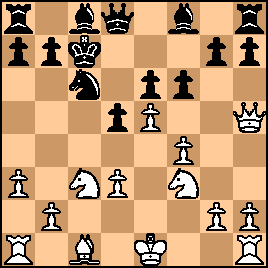
click for larger viewSchlechter's position here was not a thing of beauty, but at least he's still alive and kicking. And from here, Janowski bungled his chance of making life as tough as possible for Schlechter, who within the next few moves managed to solve most of his (self-inflicted) opening problems. |
|
May-28-25
 | | KEG: Post II
12. d4
This superficial natural looking move is another indication that Janowski was in terrible form in this match. While at first glance 12. d4 seems normal, it forfeited much of Janowski's edge by removing d4 as a square--in many variations--for Janowski's Knight and/or Bishop. 12. 0-0, keeping all his options open, was far better. 12... d4
Meanwhile, Schlechter was hard at work trying to continue repairing the damage his sloppy opening play had created for himself. But here even better was probably 12...f5. The text gave Janowski another opportunity to retain some advantage, the position now being: 
click for larger view13. b4?
As so often was the case, Janowski was marching to his own tune. Nonetheless I was surprised that so talented an attacking player as Janowski passed on the chance to try to break up Schlechter's attempted fortress with 13. f5! 13... Rc8
With this move, Schlechter had reinvented the process of castling. 14. 0-0 Kb8
Mission accomplished. Schlechter's King had now found relative safety and he was very much back in the game. 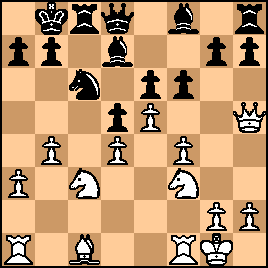
click for larger view15. Bd2 Be7
Also good for Black were 15...Ne7 (en route to f5) or 15...fxe5 (clarifying the King-side pawn structures). 16. Qh3
This was probably not bad, but--as is so often the case--it is difficult to discern Janowski's strategy. 16... Ka8
By contrast, Schlechter's play in this part of the game seems governed by his usual positional acumen and caution. His King had now found a safe haven and he had made room for his Knight on b8 as and when he wanted to open the c-file for his c8 Rook. 
click for larger view17. Kh1 f5
Finally sixing the King-side pawn chains, unless and until one side decided to start ramming with one of the g-pawns. 18. Qg3 Rg8
19. Rfb1
Now Janowski had a plan: attack on the Queen-side: 
click for larger viewFor all of the ups and downs in this game to this point, a fascinatingly unbalanced position had arisen. The sort of position in which the stronger player will likely prevail from either side of the board. 19... h6!
Combining defense with offense (a possible g5). 20. Qe1
Janowski also seemed ready to rumble, poising his Queen for play on the Queen-side and seemingly ignoring Schlechter's threats on the King-side. 20... g5
Here comes Schlechter.
21. b5!
And now Janowski counter-punched.
21... Nb8
Confirming the wisdom of his earlier 16...Ka8.
22. a4
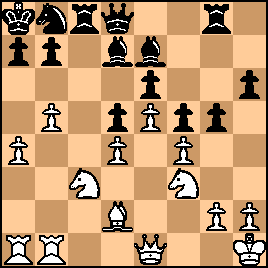
click for larger viewA battle royale seemed to be in the offing, and for the next several moves the game did not disappoint until (my explanation for what occurred) time pressure seems to have reared its ugly head causing Schlechter to weaken and present Janowski with his first chance to win a game in this match after falling behind 0-2. And then, as we shall see, a similar fate afflicted Janowski who collapsed--again seemingly because of time pressure--just as he was about to win this nearly must-win game for himself. |
|
May-29-25
 | | KEG: Post III
22... Rc4
With an attacking notion that Janowski probably did not expect to have to face from Schlechter. 22...Be8 was another god alternative. 23. a5
23. Qe3 was perhaps more prudent. But Janowski always preferred to attack, and who is to say he was wrong here! 23... Qe8
Typically for Schlechter. He sought a move that allowed play on both sides of the board. Other possibilities were 23...a6 and 23...g4. But, as will be seen, Schlechter had decided to strike first with his all-board attack. 24. Rb3
Reasonable, but obviously not anticipating Schlechter's next move, the position now being: 
click for larger view24... RxN?!
Janowski probably anticipated 24...g4 or 24...a6, each of which was arguably objectively superior to the text, which looks more like Tal than like Schlechter. 25. BxR Bxb5
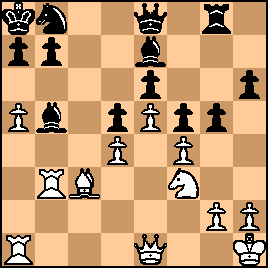
click for larger viewA wild unbalanced position had now been reached in which it is difficult to decide who if anyone was better. 26. Bb4! Bc4
26...Bd8 was probably best. A terribly complex position for both sides to handle with the clock winding down to the move-30 time control. [I am making some assumptions about the time control here based in part on what happened in this game and in part on the usual tournament time controls in effect in this era]. 27. Rb2 gxf4
28. BxB QxB
29. Rab1
This left:

click for larger view29... Qg7
29...Ba6 was probably somewhat better.
30. Qd2 Ba6

click for larger view31. Qxf4
My silicon friends tell me that best--and possibly winning for White--was 31. Ng1, presumably to allow Nh3 and a possibly Nxf4. But Janowski's entirely human move looks pretty good to me too. 31... Nc6
32. Qd2 h5!
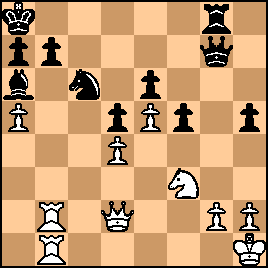
click for larger view33. h3
33. Qc1 followed by Qc5 was probably more promising, but White has various ways to make progress. The text, by creating a hole on g3, had the perhaps unintended consequence of luring Schlechter into problems. 33... Qg3
This created weaknesses Janowski didn't immediately exploit. 34. Rc1
34. Qh6 would have given Janowski . Schlechter would have almost certainly have to trade Queens allowing Janowski to seize control with 34...Qg6 35. QxQ RxQ 36. Rc1 (since the Black Knight can't take on a5 because of the back-rank mate, and after 36...Rg8 the pawn remains immune since Rc7 cannot be allowed. After Janowski's actual move, it appeared that Schlechter had survived the worst: 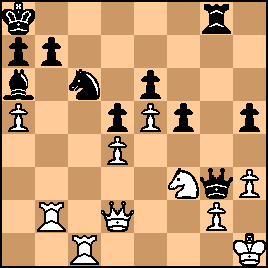
click for larger viewSchlechter could simply have played 34...Qg7 here with excellent chances of holding the game, but beginning here he seemed to lose the thread of the game and before long was dead lost--or so it seemed. |
|
May-30-25
 | | KEG: Post IV
34... f4?!
An uncharacteristically wild attacking move by--of all people--Schlechter. But, at least initially, Janowski failed to capitalize: 35. Qc3
Sloppy. 35. Rcc2 would have given Janowski excellent winning chances. 35... Bc4
36. Rcb1
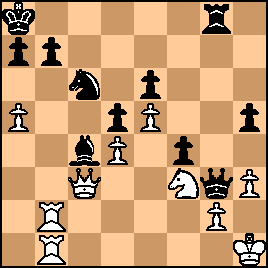
click for larger viewSchlechter's position was still problematic, but he did have a pawn for the sacrificed exchange With his Queen aggressively placed, he had more than a fighting chance to surivie. But again, he seemed to panic with: 36... Qg6?
He still seemed to have a defensible position with 36...a6 or 36...Rb8 37. Qd2 Ba6
38. Qxf4 Nxa5
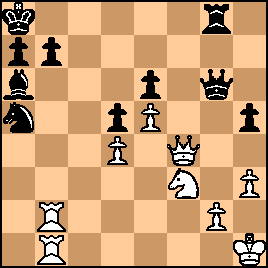
click for larger view39. Ra1
With 39. Nh4 or maybe 39. Rd1, Janowski would have had better winning chances. But all that hardly matters because Schlechter continued to play in a fog: 39... Nc4?
He had nothing better than 39...Nc6. After the text, he was in deep trouble. 40. Rf2
Janowski could also have played 40. Rf2 with a likely win. 40... Bb5
Now 41. Nh4! appears decisive, but Janowski was also inaccurate at this stage of the game. The position was now: 
click for larger view41. Ng5?
Giving Schlechter another chance which he (again_ flubbed) 41... a6?
41...a5 or 41...Kb8 were (theoretically) his only real chances. 42. h4!
Now Janowski seemed to be in his element, and Schlechter (playing far inferior chess to what he had displayed earlier in the match) seemed doomed. 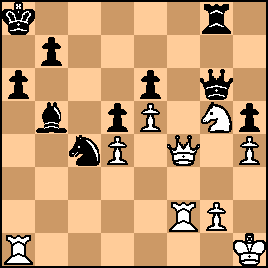
click for larger viewBased on Schlechter's horrific play over the course of the next several moves, I have to assume that he was facing time pressure with the move-45 time control looming: 42... Qd3?
Abandoning his e-pawn and leaving himself helpless to stop Janowski's attack. Once again, I have to believe Schlechter was in the throes of terrible time pressure. 43. Nxe6

click for larger view43... Rg4?
Seemingly tantamount to resignation (43...Ka7 or 43...Qh7) were the best options, but neither held much hope of holding the game. After the text, the position was: 
click for larger viewNow Schlechter was in a mating net, and appeared to have no chance to survive. But from here, and as I will discuss in my next post on this game, Janowski (perhaps also facing time pressure) completely self-destructed and by move 47--incredibly--was dead lost. Here is a not very difficult question (unless you're in time trouble), White to play and win. |
|
May-30-25
 | | KEG: Post V
44. Qf6?
As <Chessical> and <tamar> have pointed out on this site, Janowski had an easy win here with 44. Nc7+ [44...Ka7 (44...Kb8 45. Qf8+ KxN 46 Rf7+ with mate to follow shortly) 45. NxB+ Kb6 46. Qf7 Rxh4+ (46...KxN 47. Rb2+! NxR 48. Qxd5+ and mates in two) 47. Kg1 Na3 (everything else loses even faster) 48. Rf6+ KxN 49. Qxb7+ and now Black's King must walk the plank into a quickie mate]. After Janowski's actual move, he still had a clear win, especially after Schlechter's poor 44...Bc6? (44...Ka7 is the only legitimate way to extend the game). Schlechter's actual move left:

click for larger viewNow once again Janowski had a clear win--actually a number of ways to win. Chessical points out the brilliant 45. Ra6+. <vonKrolick> mentions that move as well as 45. Nc5, which is equally deadly. Janowski could also have won here with the more prosaic 45. Qd8+. But Janowski, with one more move to make before the move-45 time control played the entirely sufficient: 45. Nc7+
A decent choice with time running out.
45... Ka7

click for larger viewNow, with the time control reached, Janowski should have had ample time to calculate how to win. <Stracoonoor> has pointed out 46. Qe7 and 46. Rfa2. Perhaps Janowski was still nervous about the clock (which happens in real life!) and lost track of the fact that he had survived time pressure. In any case, Janowski here threw away his win (as pointed out by <vonKrolick>) and played: 46. Nxa6?
Of course, had Schlechter obliged by responding 46...bxN, Schlechter would still have won with 47. QxB. But now Schlechter had time to think and found the saving move: 46... Qxd4!

click for larger viewNow Janowski had to find the one and only saving move: 47. e6! But perhaps because he couldn't reconcile himself to the fact that he had blown the win, he "let the draw fly away" [I am quoting <vonKrolick] here] and played the disastrous: 47. Rb1?
Now Schlechter, having somehow survived a dead-lost position several times, pulled himself together and shifted in "let's win" mode: 47... KxN
He could also have played 47...Rxh4+ and then 48...KxN. 48. Qf8 b6
The most precise winning move, which left:

click for larger viewThere is no saving move here for White. Perhaps 49. Qc8+ Bb7 [forced] 50. Qf5 was the best practical chance. But, not unreasonably, Janowski decides to play for threats with: 49. e6

click for larger viewThe position is still tricky. Black can win with 49...Nd2 or 49...Rxh4+ or 49...Re4. But, again uncharacteristically for Schlechter, he erred and gave Janowski at least practical chances with: 49... Na5?
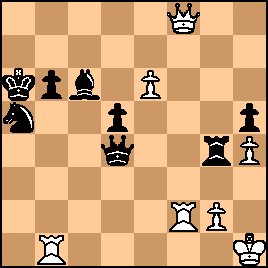
click for larger viewThe game is still a theoretical win for Black, but Janowski might have made the task at least a trifle onerous for Schlechter with 50. Re1. But now Janowski completed his collapse in this game (and in the match, since losing made the score 3-0 for Schlecter). I will cover the tragic (for Janowski) conclusion of this game that he should have won in my next post on this Game #3. |
|
May-30-25
 | | KEG: Post VI
50. e7?
As previously noted, 50. Re1 was the only (perhaps forlorn) hope. Perhaps Janowski thought he would still be able to protect his passed e-pawn with a later Re1. But Schlechter soon disillusioned him of such notion: 50... Rxh4+
51. Kg1 Qe5

click for larger viewThe game was now pretty much over. Janowski must have been furious at himself, and his subsequent play seemed designed to get himself mated sooner rather than later. 52. Qc8+ Ka7
53. Re2
Leaving the King open to devastating checks. But even with the "better" 53. Rf7 Janowski could not have expected to last very long against so fine a technician as Schlechter. 53... Qh2+
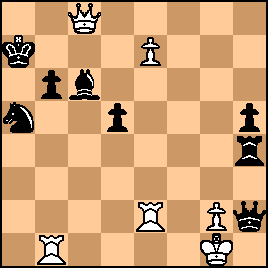
click for larger viewDid Janowski actually miss this (and the follow-up)? 54. Kf2
54. Kf1 was the only way to prolong the game at least a little. What followed was brutal: 54... Rf4+
All made possible by Janowski's dreadful 53. Re2? 55. Ke3 Nc4+
56. Kd3 Qg3+
57. Kc2 Ba4+

click for larger view0-1
It is mate in two however White plays.
Had Janowski won this game, the score would have been 2-1 in favor of Schlechter. But now the score was 3-0 (after only three games). In a match of 14 games against Schlechter (a VERY tough man to defeat), Janowski's chances were practically nil, especially given that Schlechter would have White in 6 of the possibly remaining 11 games. |
|
|
|
|





